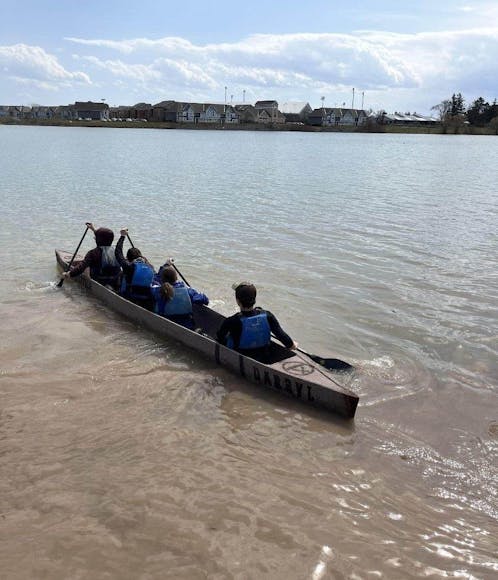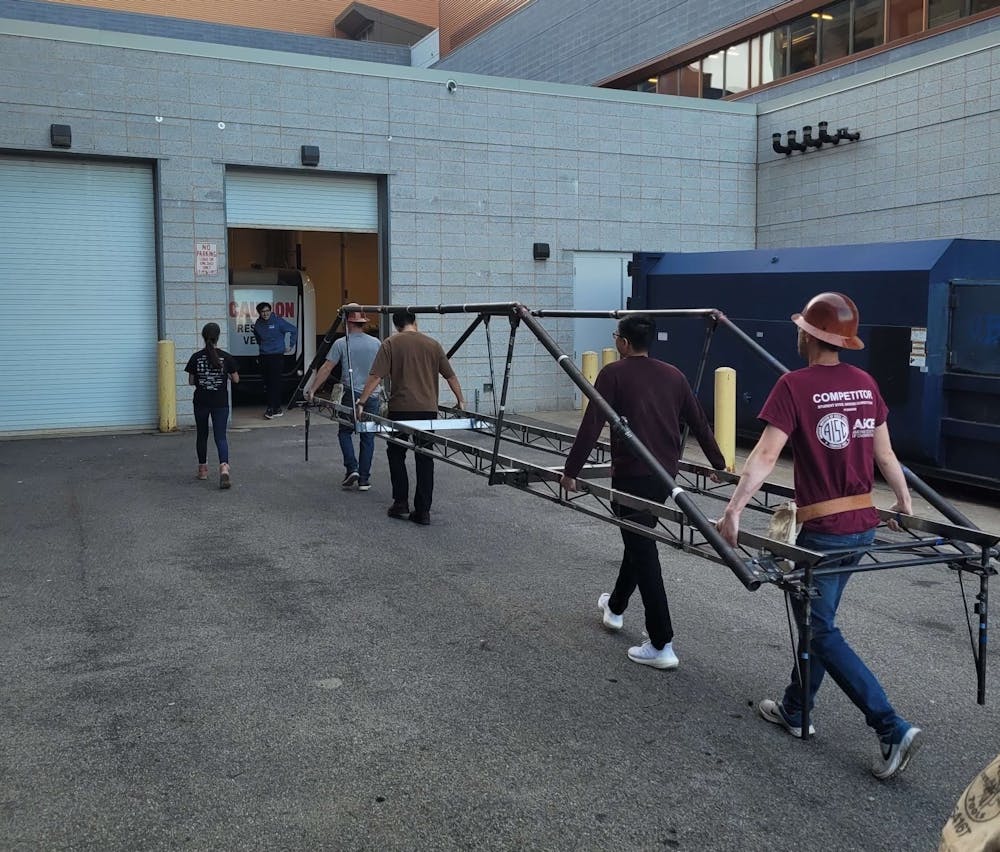UB’s student chapter of the American Society of Civil Engineers (ASCE) took home the national title and placed second internationally in the 2023 Undergraduate Seismic Design Competition, hosted in San Francisco earlier this month. They competed against 34 other teams from around the world.
And their accolades don’t end there. Alongside the Civil Engineering Department, the chapter hosted the 2023 Upstate New York-Canada ASCE Student Symposium last week. Competing against chapters from eight other chapters, UB’s chapter won first place in the steel bridge and concrete canoe competitions. ASCE is an organization that represents over 150,000 civil engineers worldwide. Its chapters provide students with support for education programs and professional development.
The club began preparation for the Student Symposium in 2022 by appointing a committee of UB ASCE members to be in charge of organizing the competition.
“Preparing for this competition has been a huge task,” junior civil engineering major and president of UB ASCE Danielle Kata said. “It’s been awesome to have a committee of really engaged and motivated people working on making it run as smoothly as possible.”
Steel Bridge Team
The steel bridge team has been designing and perfecting their bridge since the release of the competition’s rules in September.
The rules require each team to design an approximately 20-foot bridge that can carry a load of 2,500 pounds and fit in a 6-by-4-by-3.5-foot box. Teams have limited time to construct a bridge that meets these specifications.
Students used the civil engineering structural analysis program SAP2000 to determine how much the bridge would deflect — or bend — under weight at the ends of their structure.
Parts for the bridge are designed and cut before the competition. At the event, each school sent between two and six people to assemble the bridge as quickly as possible. The teams who can do so without running up the clock gain the most points.
Teams are given a final cost of construction based on the time and amount of people used to assemble the bridge. The longer a team takes to assemble the bridge and the more students they use to assemble it, the more money gets added toward the final cost of building their bridge. The total revenue each team finishes with contributes toward their overall final score.
“When we figure out who builds fastest, they build every day four or five times — building and taking it down, then load testing,” junior civil engineering major and the steel bridge team’s engagement chair, Ben Cardamone said about UB ASCE’s preparation for the steel bridge competition.
Almost all steel pieces were cut and fabricated by the UB team itself, but some precise pieces required outsourcing to local companies for water pressure cutting.
The steel bridge team received first place out of the nine teams competing at the symposium.
Concrete Canoe Team
The UB ASCE canoe team began creating the hull and mixing designs after the release of the competition’s rules in September.
The concrete canoe competition requires teams to construct a canoe from concrete and then race each other with their designs. The rules change every year, forcing competitors to tackle new challenges.
Following the completion of a rough model of the hull, they held a practice pour in November, when they troweled half and quarter-scaled canoes to test the concrete mix and get new members comfortable with the troweling process.

UB ASCE students test their concrete canoe for the concrete canoe competition.
The hull and mix designs were finalized by the end of the fall semester, and the team prepared for the full pour in late February. Only final touches to elements of the canoe’s display were left following the full pour.
Each team was scored on four different categories in the canoe competition: technical presentation, project proposal, final prototype and race times. Contenders compete in five different races, including a men’s sprint, women’s sprint, men’s slalom, women’s slalom and a coed sprint.
The UB concrete canoe team won overall, placing first in the project proposal subcategory, second in the paddling and presentation subcategory and third in the final prototype subcategory.
The team will compete in the national concrete canoe competition in June at the University of Wisconsin–Platteville.
Seismic Design Team
A week prior to the ASCE Student Symposium in Buffalo, UB’s ASCE chapter traveled to San Francisco to compete in the 2023 Undergraduate Seismic Design Competition.
Representatives from 34 colleges and universities worldwide participated in the seismic design competition.
Prior to the release of the competition’s rules in September, the leaders of UB ASCE taught younger members how to use SAP2000. The team spent several weeks trying to find a design they felt would meet all of the competition’s intricate rules.
The team then used their (sometimes newly acquired) skills with SAP2000 to model and analyze the structure against the simulated earthquake.
After the team was satisfied with the results, they constructed a test tower. The tower was tested on a handful of different simulated earthquakes, including the Kobe earthquake and the Northridge earthquake.
Following the test tower’s successful assessment, the team made small design adjustments and then built the final tower, with all team members working 12 hours per week in the final weeks before the competition.
When the tower was finished, the team built a rugged crate to pack and ship the tower to San Francisco, the site of the competition.
UB ASCE won second place in the world and first place in the nation at the 2023 Seismic Design Competition.
“The reason that we placed so high is because our team is comprised of 16 selfless members,” Eric Maier, a senior civil engineering major and the seismic design team’s project manager, said. “Everyone did their part to help, especially during crunch time.”
Maier also believes the team’s success stems from their continued dedication and confidence in their design.
“We stuck to our plan, prioritized the project over pretty much everything else, and it paid off big time with the best finish in the U.S.,” Maier said. “It is an awesome feeling, and everyone on this team earned it.”
The features desk can be reached at features@ubspectrum.com





